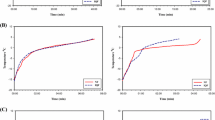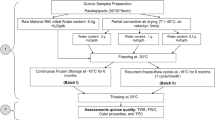Abstract
The development of a simple and effective long-term storage protocol for harvested fresh Undaria pinnatifida is required to increase the market for U. pinnatifida products. We investigated the quality of U. pinnatifida after the application of various freezing and thawing methods to establish an optimum storage protocol. Four freezing temperatures (−40, −30, −20, and −10 °C), four freezing conditions (in air without seawater and with 50, 75, and 100 % seawater), and four thawing times (6, 12, 18, and 24 h) were employed. Changes in color value, tensile strength, total bacterial count, and most probable number of coliforms were measured. The best method for preserving the overall quality of U. pinnatifida is freezing at −30 °C with 50 % seawater and thawing in running tap water for 6 h. During retail display, changes in color, odor, tensile strength, and bacterial count of U. pinnatifida that had been freeze-thawed under optimum conditions were also measured, and a sensory evaluation was performed. There was no significant difference compared with the control within two days at 10 °C. In conclusion, we developed a simple and effective long-term storage protocol that led to no significant loss of quality of fresh U. pinnatifida.
Similar content being viewed by others
References
Ministry for Food, Agriculture, Forestry and Fisheries (2009) Food, agriculture, forestry and fisheries statistical yearbook (in Korean). Dongyang P&C Co. Ltd., Anyang
Choi JH, Kim IS, Kim JI, Yoon TH (1991) Studies on the antiaging action of brown algae (Undaria pinnatipia). 1. Dose effect of alginic acid as a modulator of anti-aging action in serum lipids (in Korean with English abstract). Korean J Gerontol 1:173–178
Kim KH, Kim CS (1982) Studies on the manufacture of Undaria pinnatifida laver and its physicochemical properties (in Korean with English abstract). Korean J Food Sci Technol 14:336–341
Cho JY, Kang JY, Khan MNA, Park NH, Kim SK, Hong YK (2007) Anti-inflammatory activity of Undaria pinatifida and Laminaria japonica (Phaeophyta). J Fish Sci Technol 10(3):127–132
Kim KH, Cheng DJ (1984) Optimum conditions for extracting alginic acid from and amino acid composition of its extraction residue (in Korean with English abstract). Korean J Food Sci Technol 16:336–340
Sato M, Hosokawa T, Yamaguchi T, Nakano T, Muramoto K, Kahara T (2002) Angiotensin I-converting enzyme inhibitory peptides derived from Wakame (Undaria pinatifida) and their antihypertensive effect in spontaneously hypersensitive rats. J Agric Food Chem 50:6245–6252
Suetsuna K, Kaekawa K, Chen JR (2004) Antihypertensive effects of Undaria pinnatifida (Wakame) peptide on blood pressure in spontaneously hypersensitive rats. J Nutr Biochem 15:267–272
Bojakowski K, Abramczyk P, Bojakowska M, Zwolinska A, Przybylski J, Gaciong Z (2001) Fucoidan improves renal blood flow in the early stage of renal ischemia/reperfusion injury in the rat. J Physiol Pharmacol 52:137–143
Maeda H, Hosokawa M, Sashima T, Funayama K, Miyashita K (2005) Fucoxanthin from edible seaweed, shows an antiobesity effect through UCP1 expression in white adipose tissues. Biochem Biophys Res Commun 332:392–397
Murata M, Ishihara K, Saito H (1999) Hepatic fatty acid oxidation enzyme activities are stimulated in rats fed the brown seaweed, Undaria pinnatifida (Wakame). J Nutr 129:146–151
Kim SJ, Kim HJ, Moon JS, Kim JM, Kang SG, Jung ST (2004) Characteristic and extraction of fucoxanthin pigment in Undaria pinnarifida (in Korean with English abstract). J Korean Soc Food Sci Nutr 33:847–851
Beak EY (2007) A study on the distribution structure of seaweed market in Korea (in Korean with English abstract). Korea Marit Rev 272:55–68
Li B, Sun DW (2002) Novel methods for rapid freezing and thawing of foods—a review. J Food Eng 54:175–182
Taylor R, Fletcher RL (1999) Cryopreservation of eukaryotic algae—a review of methodologies. J Appl Phycol 10:481–501
Korea Food and Drug Administration (2008) Food Standards Codex (in Korean). Korean Foods Industry Association, Seoul
Kim HJ, Choi JI, Kim JH, Chun BS, Ahn DH, Kim GH, Byun MW, Lee JW (2009) Improvements in storage stability of Undaria pinnatifida after gamma irradiation (in Korean with English abstract). Korean J Food Preserv 16:590–593
Persson PO, Lodhl G (1993) Freezing technology. In: Mallett CP (ed) Frozen food technology. Blackie, Glasgow, pp 20–58
Reid DS (1983) Fundamental physicochemical aspects of freezing. Food Technol 37(4):110–115
Reid DS (1990) Optimizing the quality of frozen foods. Food Technol 7:78–82
Agnelli ME, Mascheroni RH (2002) Quality evaluation of foodstuffs frozen in a cryomechanical freezer. J Food Eng 52:257–263
Boonsumrej S, Chaiwanichsiri S, Tantratian S, Suzuki T, Takai R (2007) Effects of freezing and thawing on the quality changes of tiger shrimp (Penaeus monodon) frozen by air-blast and cryogenic freezing. J Food Eng 80:292–299
Heldman DR (1982) Food properties during freezing. Food Technol 36:92–96
Heldman DR (1983) Factors influencing food freezing rates. Food Technol 37:103–109
Lucas T, Raoult-Wack AL (1998) Immersion chilling and freezing in aqueous refrigeration media: review and future trends. Int J Refrig 21:419–429
Fennema OR, Powrie WD, Marth EH (1973) Low-temperature preservation of foods and living matter. Marcel Dekker, New York
Kalichevsky MT, Knorr D, Lillford PJ (1995) Potential food applications of high-pressure effects on ice–water transitions. Trends Food Sci Technol 6:253–258
Korea Food Industry Association (2009) Korea Food Standards Codex (in Korean). Munyoungsa, Gwacheon-si
Acknowledgments
This work was supported by the Cooperative Research Program for Agriculture Science and Technology Development (project no. PJ004186), Rural Development Administration, Republic of Korea, and the Priority Research Centers Program through the National Research Foundation of Korea (NRF), funded by the Ministry of Education, Science and Technology (2009-0093813), Republic of Korea.
Author information
Authors and Affiliations
Corresponding author
Rights and permissions
About this article
Cite this article
Choi, JS., Lee, BB., An, S.J. et al. Simple freezing and thawing protocol for long-term storage of harvested fresh Undaria pinnatifida . Fish Sci 78, 1117–1123 (2012). https://doi.org/10.1007/s12562-012-0529-x
Received:
Accepted:
Published:
Issue Date:
DOI: https://doi.org/10.1007/s12562-012-0529-x




